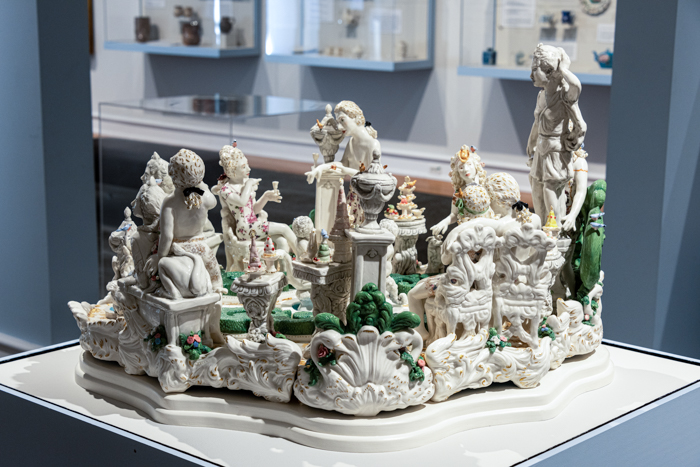INTERVENTIONS AT THE MINT MUSEUM
Mint Museum, Charlotte, NC
Interventions at Mint Museum Randolph
If you walk through the galleries at Mint Museum Randolph, the art is largely organized by region, type, or era. There are galleries for European art, African art, art of the Ancient Americas, Native American art, and decorative arts. However, within some of these galleries, there are works displayed that are “out of place” or “out of time.” Interventions seek to question the past against the present by placing contemporary artworks alongside works from other eras.
Interventions: Portals to the Past: British Ceramics 1675 – 1825
This exhibition presents over 200 examples of British ceramics. Visitors can learn about these pieces’ functions, styles, manufacturing techniques, and makers. Each region or manufacturer had a unique style and method of creating ceramics, which can be seen in the wide variety of works on display. Included in the exhibition are traditional styles like blue and white Delftware, vessels made to look like vegetables or fruits, commemorative teacups, allegorical figures, decorative figurines of animals, and many more. You can view an online version of this exhibition here.
This exhibition already invites the viewer to analyze our relationship to the past by means of its title. However, in bringing contemporary pieces to this gallery, we can find new ways of looking at a medium’s influence on our present-day society.
Antemann’s work proves that the art of ceramics is still relevant, but its function has changed. Her art focuses on how ceramics exist in the domestic lives of those who own them and what meanings are ascribed to them. Her style is based on that of 18th-century ceramics because she believes that recreating traditions allows us to find new interpretations in the present.
This meeting of past and present is clear in Antemann’s A Stage for Dessert. Numerous figures stand around at a dessert banquet in lively, lighthearted positions. However, Antemann is joking with the viewer to comment on the flirtatious, playful, or even risqué nature of the figures. What could once signify a deep meaning to a 19th-century owner, such as an allegory or a representation of a season, has been adapted into a less serious object.
- Prurient porcelain: the come-hither ceramics of Chris Antemann, by Michael Upchurch
Information courtesy of mint.wiko.pbworks.com
A Stage for Dessert
Interventions: Portals to the Past: British Ceramics 1675 – 1825
Images courtesy of The Mint Museum of Art & Ferrin Contemporary
A Stage for Dessert
Previous Installation at Hillwood Estate & Gardens
“An Occasion to Gather Chris Antemann’s porcelain centerpiece, is filled with 18th-century style ceramic sweets, takes inspiration from the garden sculptures and eighteenth-century design of Hillwood’s French parterre. As with the dining room table display, here Antemann references eighteenth-century dining culture and the porcelain centerpieces commonly used as table decoration by European elites.“
“Antemann integrates porcelain figures into her reconception of the French parterre. “I imagined what lives were like in the eighteenth century, what these figures would have been doing, what the collectors of these figures would have been doing,” she said. “My centerpiece is a seductive playground for the porcelain figure; they are not static on the base, but in the world, playing and enjoying the environment.” The tableware from Hillwood’s collection on the breakfast room table includes porcelain from a dessert service made by the Jacob Petit manufactory in France around 1835 (acc. no. 24.120), French glassware dating to the 1700s (acc. nos. 23.312–315), and porcelain and silver-gilt flatware made in Russia in the 1800s (acc. no. 25.479).“
–Dr. Rebecca Tilles, associate curator of 18th-century French and Western European Fine and decorative arts, Hillwood Estate & Gardens
–Images courtesy of Hillwood Estate, Museum & Gardens, photographed by Erik Kvalsvik
Chris Antemann is known for work inspired by 18th-century porcelain figurines, employing a unity of design and concept to simultaneously examine and parody male and female relationship roles. Characters, themes, and incidents build upon each other, effectively forming their own language that speaks about domestic rites, social etiquette, and taboos. Themes from the classics and the romantics are given a contemporary edge; elaborate dinner parties, picnic luncheons, and ornamental gardens set the stage for her twisted tales to unfold.
















You must be logged in to post a comment.